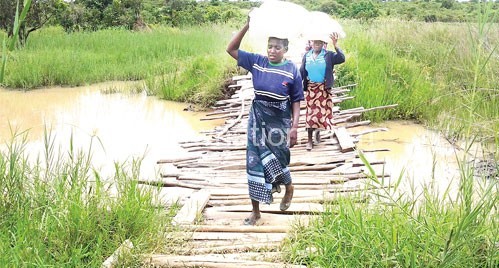The river between Batumeyo and growth

There is a marshy river between Group Village Head (GVH) Batumeyo’s area and Mbawa Trading Centre in Mzimba South. The wide split is called Lwasokozi, a stream which flows into South Rukuru River.
For visitors, crossing the divide between the cut-off communities and their source of essential goods and services is a glimpse of a time-honoured barrier on the predominantly ragged network in remote parts of Mzimba.
“It’s painful. We have three bridges, but none of them is passable,” says Kabaza Village Development Committee (VDC) chairperson Peter Hara, reflecting an endless cry of the rural dwellers.
Standing on either riverbank, the poor state of the ‘three bridges’ flashes pitifully: residents hopping precariously on a shaky crossover comprising pieces of slippery rotten wood spaced far apart. When the skipping is over, another crude stop-gap with shattered planks tilting on an insecure angle awaits them. Those walking extra carefully to avoid capitulating into the deep pools under the skewed woodwork are destined for something locals liken to ‘jumping from a frying pan into the fire’ because at the very end of the valley of hopelessness lies yet another ‘deathtrap’—a disintegrating bridge in need of urgent repairs.
This is the journey the people of Kabaza have to surmount to get to Makosikazi and Embangweni, where the nearest health centres are.
“We are cut off from the market, maize mills and health facilities,” says Lexa Kavuta, 56.
Mbawa Primary School may be a 10-minute walk from Kavuta’s household in Batumeyo, but Lwasokozi leaves two of her five children enduring over an hour-long walk to get to a reachable alternative at Matikije.
She feels bridging the stream would also close the gaps on the rural community’s strides for safe motherhood.
She recalls: “One day, a woman in labour delivered in the middle of the marsh. There was no one to help her cross the bridge or rush her to Embangweni where midwives, nurses and other skilled workers are.”
According to Hara, nearly three of four people at Mbawa Trading Centre have to cross the neglected hurdle to get home or access basic needs.
Locals say they end up selling their farm produce cheaply to vendors because they cannot shoulder heavy loads across the risky bridges.
During a visit, pedestrians and cyclists hauling bags of maize on their heads were spotted heading to Mbawa where a maize mill and market is situated. Their risky hopping where others fall and lose valuables into the water is a human face of the neglected problems the community undergo to get essential services.
“Almost every week, we have people slipping on the bridges and losing their maize grain, flour, mobile phones, money and other valuable possessions into the water,” says Village Head Soget Ndolo whose village is among the worst hit.
The sopped grains and coins can be seen at the bottom of shallower waters which flood when between February and April. When it becomes impassable, the residents of Batumeyo and Bonyonga have to surmount an extra distance to get to the hospitals which are already situated well beyond the government-recommended standard of not more than 15km from the target localities.
The area has never had a bridge—save for the rotting poles and planks crudely laid by locals in a self-help initiative. Village heads Bonyonga and Batumeyo says the district council has done nothing except erecting pillars despite receiving numerous complaints.
And a tale is told of how the problem has become a handy tool for electoral campaign, with one parliamentary candidate buying village heads beer worth K20 000 after touring the village.
“We drunk till the last man fell asleep, but nothing had changed when we woke up the next morning,” says Batumeyo, whose people collected sand for the project although the district commissioner Moses Chimphepo says the council has no capacity to upgrade the bridges.
Tired of waiting, the traditional leaders and their people say they will march and camp at the district council offices so that the DC can explain why authorities are doing nothing while the situation worsens.
The planned vigil is a different way of showing power holders that they will not sit back until their right to development is respected, they say.
But Chimphepo says the council does not have the finances for bridging the wide marsh. He says the council relies on constituency and local development funds which are hardly adequate.
“It would be easier to repair the bridge if the project was under the Roads Authority, but it is one of many projects requiring the council’s limited resources,” said Chimphepo, urging the locals to continue using alternative routes.
Chimphepo says bridges, like roads, are constructed after analysing the cost and benefits of doing so.
Yet the affected people in the maize and tobacco-growing communities say other routes mean an approximately one-hour journey to Embangweni Hospital takes up over three hours.
“This could be the reason most women deliver in risky conditions at home,” says Kavuta.
Since last year, the Church and Society Programme of the CCAP Livingstonia Synod with funding from the Danish Church Aid has been empowering the community advocacy skills and human rights education so that they are able to decide and reclaim their rights.
District project officer Happy Mhango says most Malawians live and grow up in deplorable conditions due to lack of necessary skills to engage duty-bearers on developmental matters.
“Most Malawians allow themselves to be teated like beggars, instead of holding public servants accountable. Sadly, the area has no active VDCs despite the so-called decentralisation efforts,” explains Mhango.
But like Batumeyo villagers say, an opinion is gaining sway that enough is enough.





